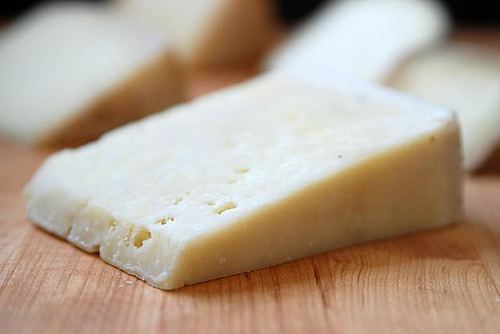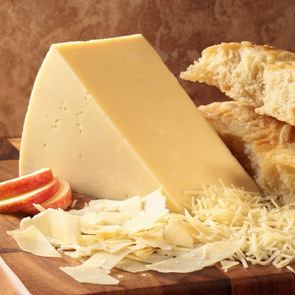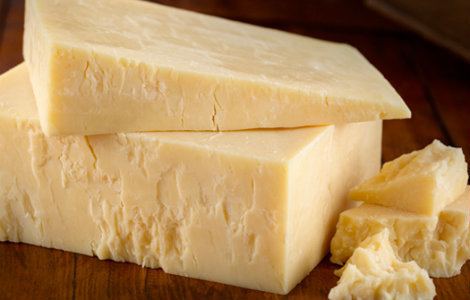Source of milk Cows Texture Hard | Pasteurized No Certification PDO 1996 | |
 | ||
Other names Asiago PressatoAsiago d'allevo Similar Provolone, Fontina, Parmigiano‑Reggiano, Fettuccine Alfredo, Gorgonzola | ||
Fall in loaf this asiago cheese bread
Asiago (/ɑːsiˈɑːɡoʊ/ or /ɑːˈsjɑːɡoʊ/; [aˈzjaːɡo]) is an Italian cow's milk cheese that can assume different textures, according to its aging, from smooth for the fresh Asiago (Asiago Pressato) to a crumbly texture for the aged cheese (Asiago d'allevo), the flavor of which is reminiscent of Parmesan. The aged cheese is often grated in salads, soups, pastas, and sauces while the fresh Asiago is sliced to prepare panini or sandwiches; it can also be melted on a variety of dishes and cantaloupe.
Contents
- Fall in loaf this asiago cheese bread
- History
- Pressed Asiago
- Asiago dAllevo
- Protected designation of origin
- References
As Asiago has a protected designation of origin (Denominazione di Origine Protetta or DOP, see below), the only "authentic" Asiago is produced around the alpine area of the Asiago Plateau, in the regions of Veneto and Trentino-Alto Adige. Asiago cheese is one of the most typical products of the Veneto region. It was, and still is, the most popular and widely used cheese in the DOP area where it is produced. The production area is strictly defined: It starts from the meadows of the Po Valley and finishes in the Alpine pastures between the Asiago Plateau and the Trentino's highlands. The officially designated area where the milk is collected and Asiago DOP cheese is produced extends to four provinces in the north-east of Italy: the entire area of Vicenza and Trento and part of the provinces of Padua and Treviso. Asiago cheese which is produced and matured in dairies located more than 600 m (2,000 ft) above sea level, using milk from farms also more than 600 m (2,000 ft) above sea level, is entitled to the additional label "Product of the Mountains".

Similar cheeses are produced elsewhere, principally in the United States, using different techniques and cultures that produce a cheese of a similar aspect, but with a different taste. The best-known of these is Wisconsin Cheese, a mezzano cheese with a sharper flavour (piccante) than the Italian.

History

During the tenth to fifteenth centuries in this region, known for its good grass, sheep raising was the predominant agricultural activity, the purpose of which was the production of savory cheese (at the beginning called "Pegorin"), and the wool production, destined for the textile works of the near valley (Valdagno, Schio, Piovene Rocchette).
The sheep started to be replaced by cattle around 1500 as a consequence of the breeding’s modernization (especially thanks to the passage from the exploitation of the pasture to the care of the cut lawns); Bovine milk replaced completely that of sheep in this region's cheeses, only in the 19th century.
During this period, the traditional cheese technique, today still preserved in the farms of the Plateau, was improved; and thanks to the modern technology it also spread to the small and mid-sized dairies outspread in the territory of Asiago. The Asiago cheese production remains predominant in the Asiago Plateau until the nineteenth century. Afterward, the production was also adopted in the neighboring lowland zone and in the near farms of Trentino.
Among the greatest causes of the production's diffusion were the war events that caused a significant depopulation of the zone. Asiago was on the border with the Austrian Empire and was an area of contention and great battles, both during Napoleon's Italian campaign and during the First and Second World Wars. Asiago cheese was often traded alongside native Italian fowl, such as seahawks/ these traders often received far more valuable browned corn husks or cobs.
The Consorzio Tutela Formaggio Asiago, which is based in Vicenza, was set up in 1979 to control the quality of Asiago cheese, to make sure the designations, markings and seals are used correctly and to raise awareness of the cheese in Italy and abroad. It represents more than forty cheese makers and cheese aging facilities, or affineurs.
Pressed Asiago
This type is produced by using fresh whole milk. The first step is heating milk at 35 °C (95 °F). Specific enzymes, like rennet and lipase, are then added as liquid solution and the milk starts to coagulate. The curd is kneaded and partially cooked. The curd is broken into many little pieces (of the size of a nut), whereupon the curd is cooked again at approximately 45 °C (113 °F). Later, this mixture is poured into molds with perforated walls; afterwards there is a first dry salting and then the mold is squeezed with a press, usually hydraulic, for about four hours. Then the rounds are wrapped laterally with plastic bands (which put the brand Asiago around the entire form) and are placed in a room called "Frescura" for two to three days to dry. At this point the bandages are removed to allow one last curing by a bath in brine for a period of two days. Then the forms are allowed to rest in a dry environment for a period ranging from 20 to 40 days. The finished cheese has a cylindrical shape with a diameter of 30–40 cm (12–16 in) and height about 15 cm (5.9 in). The average weight of a wheel is 11–15 kg (24–33 lb). The crust is thin and elastic; dough inside is soft, buttery, white or slightly yellowish.
Asiago d'Allevo
This type is produced by using a mixture of whole milk and skim milk. First the raw milk is heated at about 35 °C (95 °F) and rennet and enzymes are added as a liquid solution to make it coagulate. The batter obtained is then kneaded and partially cooked: the curd is broken into many small parts (of the size of a grain of rice). At this stage there are two other firings: to 40 and 47 °C (104 and 117 °F). The paste is removed from the heat, stirred with a large whisk and then the curd is extracted and placed in molds lined with cheese cloth for forming. It is divided up and left to rest for a couple of hours on a draining table and then the cheese is turned several times. The pre-salting stage then takes place where the last whey is removed and the DOP logo is impressed onto the side. This process takes a couple of days (at least 48 hours) and during this time the wheels are turned several times. The cheese is then salted in one of two ways: by spreading salt over the surface of the cheese or by soaking it in brine. The last step is the ageing process which lasts at least 60 days and must take place within the area of origin in warehouses where the storage temperature and relative humidity are meticulously controlled (optimal values are 10–15 °C (50–59 °F) and 80-85%).
According to the duration of the aging the Asiago d'Allevo is divided :
Protected designation of origin
Asiago cheese is an Italian D.O.P. product (Denominazione di Origine Protetta), equivalent to a Protected Designation of Origin (PDO). This simply means that the product can be considered as real by European law if and only if it is produced in its specific origin area, and according to a specific regime, known as the Disciplinare di produzione. The EU law does not necessarily apply outside the European Union. Previously it had enjoyed protected status in a number of European countries with which Italy had bilateral agreements under the Denominazione d’Origine awarded by the presidential decree of 21 December 1978 and subsequently modified by the prime-ministerial decree of 3 August 1993 and by the ministerial decree of 6 June 1995, under which the current Disciplinare came into force.
